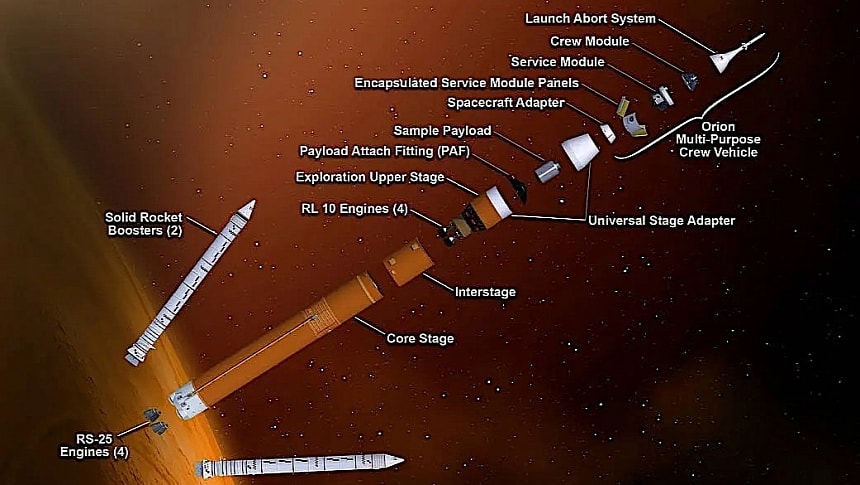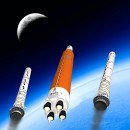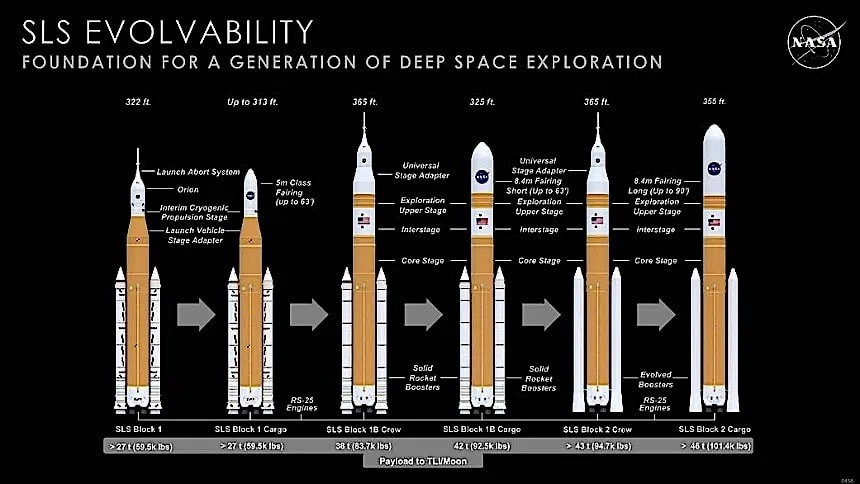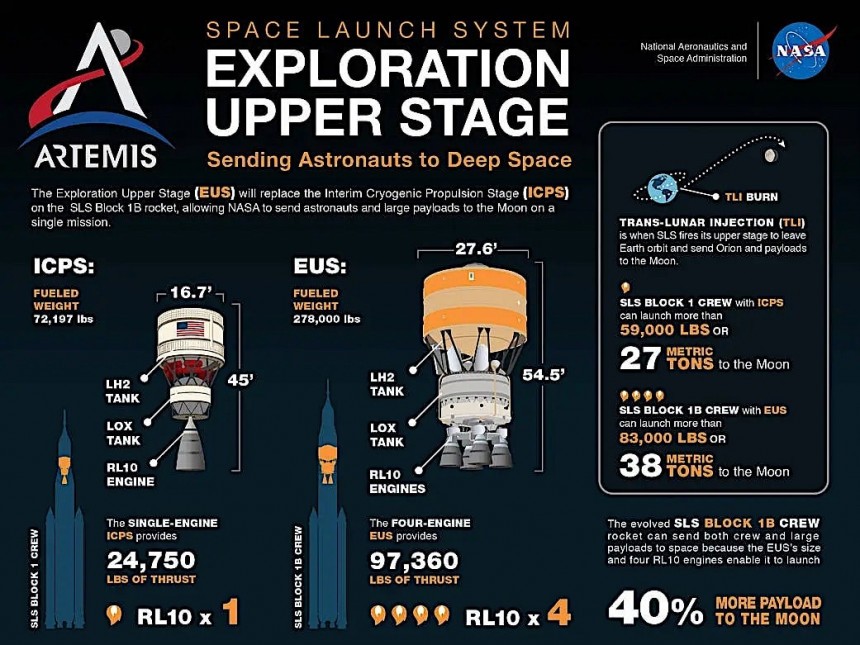In November 2022 American space agency NASA kicked off its second Moon exploration program with the launch of the Artemis I mission. It was the first time the organization used its new and mega-powerful Space Launch System rocket and the Orion capsule, both of which worked flawlessly to prove that flights with crew on board are just around the corner.
The SLS that pushed Orion on its trip around the Moon during Artemis I is called Block 1, and it is the same configuration that will be used for the second and third missions of the program, the ones that will carry humans around the Moon and then land them up there.
The numbers for Block 1 are well-known and pretty impressive. At the time of its launch the world's most powerful rocket, the hardware can carry a total of 59,500 pounds (27 metric tons) of cargo, pushed away from Earth's gravity by a four-engine core stage and a pair of boosters that generate a combined 8.8 million pounds of thrust. That's 15 percent more than what the previous rocket that carried people to the Moon, Saturn V, was capable of.
However, the Artemis program goes far beyond these three initial missions, and it might even evolve into a vehicle that could allow us to visit planet Mars. As such, the SLS is poised to be transformed into something even greater for future missions.
For flights four to nine, NASA is planning on using an updated version of the mega-rocket called Block 1B, and from the ninth mission onward, it will shift to the Block 2 variant. It's the 1B we're going to focus on today, because NASA just gave us an update and spilled the full list of numbers that make up this impressive piece of hardware.
As its name says, Block 1B will not be fundamentally different compared to Block 1. Technically speaking, the new rocket will use the same core stage and booster design, along with all major components. But there will be differences, two major ones, and they will impact the rocket's capabilities.
The first change NASA plans to bring to the SLS for the Block 1B incarnation is a more powerful second stage, the one that is used while the rocket is in space. NASA calls this the interim cryogenic propulsion stage (ICPS), and it currently uses a single RL10 engine. For Block 1B that single engine will be replaced by a more powerful setup of four of them, which will be called the exploration upper stage (EUS).
As it stands, the ICPS weighs 72,197 pounds (32.7 metric tons) in its fueled configuration and delivers 24,750 pounds of thrust. It measures 16.7 feet (5 meters) in diameter and is 45 feet (13.7 meters) tall.
The EUS that will replace it comes in at 27.6 feet (8.4 meters) in diameter and 54.5 feet (16.6 meters) tall. Its quartet of engines will give it a punch totaling 97,360 pounds of thrust. The EUS will also use a new kind of battery, giving it enough juice to support the mission for the first eight hours of flight, compared to just two the ICPS is capable of now.
The second big change the SLS Block 1B will receive is a more potent universal stage adapter. That's the piece of hardware that links the rocket to the Orion spacecraft, and it is crucial in determining how much weight the assembly can carry into space.
As said, in Block 1 setup of the SLS can lift a total of 59,000 pounds of cargo. The new adapter will allow Block 1B to lift a lot more, 84,000 pounds (38 metric tons) in the crew configuration, and possibly as much as 92,500 pounds (42 metric tons) in the cargo version.
It is also equipped with enough room to carry large pieces of equipment, including for the Gateway space station NASA intends to build in orbit around the Moon: 10,000 cubic feet (286 cubic meters) of space are available for that.
Unlike the Block 1, which can only be launched in limited numbers to the Moon, the 1B's improved capabilities should allow two daily launch opportunities, according to NASA. And that is very desirable, given how the U.S. is more or less planning to colonize the Moon in the coming years.
The SLS Block 1B is set to fly for the first time for Artemis IV, a mission that is tentatively planned for late 2028. That's four years from now, but NASA is already hard at work building the hardware.
At the Michoud Assembly Facility in New Orleans early manufacturing of the rocket is already underway, while the Stennis Space Center in Bay St. Louis, Mississippi, is gearing up to conduct a series of tests on the EUS and its four engines.
As for the SLS Block 2, the culmination of the mega-rocket program and the successor of 1B, that one will lift off in 2033, once the Artemis IX mission gets going.
The numbers for Block 1 are well-known and pretty impressive. At the time of its launch the world's most powerful rocket, the hardware can carry a total of 59,500 pounds (27 metric tons) of cargo, pushed away from Earth's gravity by a four-engine core stage and a pair of boosters that generate a combined 8.8 million pounds of thrust. That's 15 percent more than what the previous rocket that carried people to the Moon, Saturn V, was capable of.
However, the Artemis program goes far beyond these three initial missions, and it might even evolve into a vehicle that could allow us to visit planet Mars. As such, the SLS is poised to be transformed into something even greater for future missions.
For flights four to nine, NASA is planning on using an updated version of the mega-rocket called Block 1B, and from the ninth mission onward, it will shift to the Block 2 variant. It's the 1B we're going to focus on today, because NASA just gave us an update and spilled the full list of numbers that make up this impressive piece of hardware.
As its name says, Block 1B will not be fundamentally different compared to Block 1. Technically speaking, the new rocket will use the same core stage and booster design, along with all major components. But there will be differences, two major ones, and they will impact the rocket's capabilities.
As it stands, the ICPS weighs 72,197 pounds (32.7 metric tons) in its fueled configuration and delivers 24,750 pounds of thrust. It measures 16.7 feet (5 meters) in diameter and is 45 feet (13.7 meters) tall.
The EUS that will replace it comes in at 27.6 feet (8.4 meters) in diameter and 54.5 feet (16.6 meters) tall. Its quartet of engines will give it a punch totaling 97,360 pounds of thrust. The EUS will also use a new kind of battery, giving it enough juice to support the mission for the first eight hours of flight, compared to just two the ICPS is capable of now.
The second big change the SLS Block 1B will receive is a more potent universal stage adapter. That's the piece of hardware that links the rocket to the Orion spacecraft, and it is crucial in determining how much weight the assembly can carry into space.
As said, in Block 1 setup of the SLS can lift a total of 59,000 pounds of cargo. The new adapter will allow Block 1B to lift a lot more, 84,000 pounds (38 metric tons) in the crew configuration, and possibly as much as 92,500 pounds (42 metric tons) in the cargo version.
Unlike the Block 1, which can only be launched in limited numbers to the Moon, the 1B's improved capabilities should allow two daily launch opportunities, according to NASA. And that is very desirable, given how the U.S. is more or less planning to colonize the Moon in the coming years.
The SLS Block 1B is set to fly for the first time for Artemis IV, a mission that is tentatively planned for late 2028. That's four years from now, but NASA is already hard at work building the hardware.
At the Michoud Assembly Facility in New Orleans early manufacturing of the rocket is already underway, while the Stennis Space Center in Bay St. Louis, Mississippi, is gearing up to conduct a series of tests on the EUS and its four engines.
As for the SLS Block 2, the culmination of the mega-rocket program and the successor of 1B, that one will lift off in 2033, once the Artemis IX mission gets going.




















